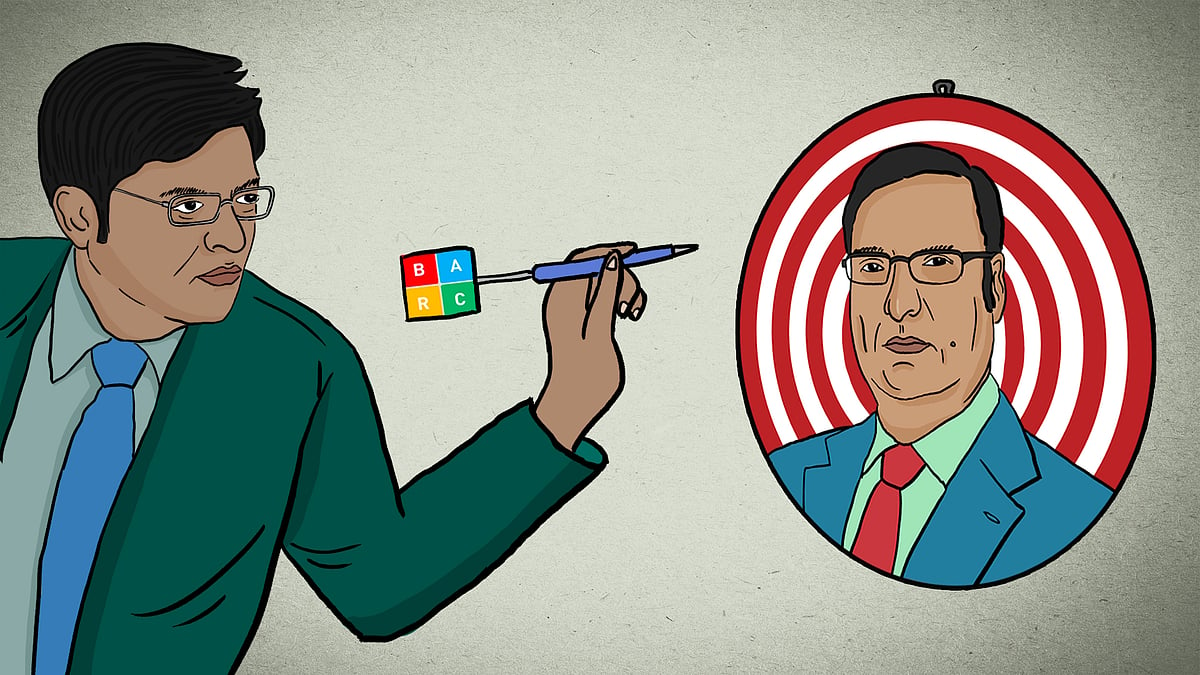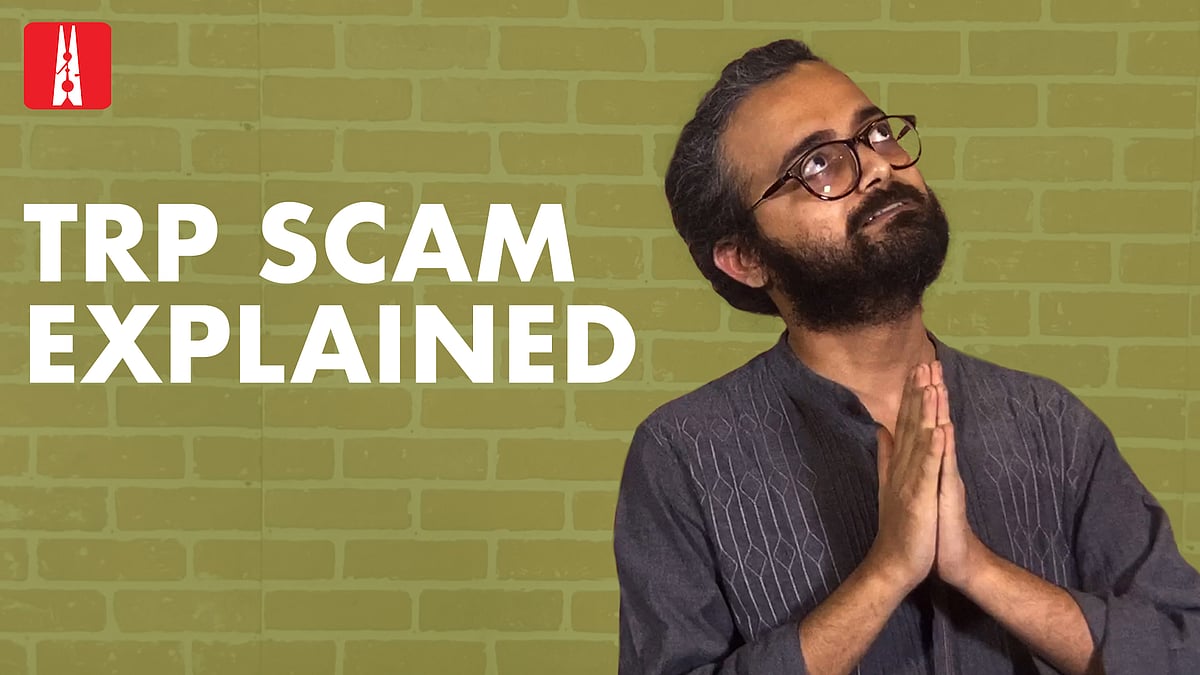TRP scam: BARC’s ratings suspension has news channels worried, but not advertisers
News is not central to an advertiser’s television plan, since it constitutes less than 10 percent of total viewership across the country.
After a suspension of nearly five months, the Broadcast Audience Research Council was asked to further withhold television ratings for news channels. In a letter dated February 15, 2021, the ministry of information and broadcasting told BARC not to resume the ratings until a committee examining discrepancies in the TRP system submitted its report.
BARC’s initial suspension in October came after the Mumbai police unearthed a TRP scam, alleging that a few media houses bribed homeowners to “rig” their TV ratings. The organisation continues to release ratings for the news genre as a whole, but not for individual news channels.
In the wake of the extended suspension, TV news channels seem to be more ill at ease than advertisers, for the TRP system is the life-blood of the TV news model. Advertisers place their ads on a news channel based on TV ratings, in conjunction with other metrics.
To get a sense of how ads are being deployed on news channels in the absence of ratings, and its effects on the channels, Newslaundry spoke to professionals in the advertising and TV news industries.
Advertising insiders maintained that the industry has kept its cool in the last three months. This is unlike the TV news space, which is trying to come to terms with the lack of viewership data and its lasting consequences.
 Arnab Goswami versus Rajat Sharma: How BARC became a conduit to settle scores
Arnab Goswami versus Rajat Sharma: How BARC became a conduit to settle scores Ferrari, Rolex, and TRP rigging: Audit report exposes malpractices at BARC
Ferrari, Rolex, and TRP rigging: Audit report exposes malpractices at BARC ‘One must play dirty’: Chats show how Arnab Goswami plotted with BARC CEO
‘One must play dirty’: Chats show how Arnab Goswami plotted with BARC CEO Explained: What's the 'TRP scam' and how was it done
Explained: What's the 'TRP scam' and how was it done‘News is not central to advertisers’
While TV news channels run largely on ad revenue, they are not where advertisers line up first to sell their products. All the news channels put together make up less than 10 percent of the entire TV viewership in the country, according to media consultant Chintamani Rao, a veteran who has dabbled in both news and advertising spaces.
Rao pointed out that owing to the size of the TV genre, news is not central to any advertiser’s television plan.
“Despite all the sound and fury you see on English news channels, they make up about 0.04 percent of the total television viewership,” he said, adding that not being on a news channel will not affect “a single advertiser” in the country. Another advertising professional pegged the viewership share of English news at a liberal one percent.
Why then do advertisers buy slots on news channels? Rao said it was either to increase their exposure or to reach their target audience in a more streamlined way.
A media professional explained, on the condition of anonymity, how news is not used as a foundation for advertisers to market their products. If an advertiser is launching a product campaign, it will look at the television genre with the most reach and the highest share of viewership. In other words, advertisers will first approach general entertainment channels, followed by movie, music and sports channels. Only then do news channels come into the mix.
Notably, advertisers don’t anchor their campaigns on a single news channel but in a bouquet or combination of news channels that run their campaigns simultaneously.
Besides, advertisers also approach news channels if they want to target a specific audience. Aunindyo Chakravarty, former managing editor of NDTV India and NDTV Profit, said the ratings for English news channels are given in the parameter 22 + AB male. This means the target audience is men in the top two income categories in metro cities who are aged 22 and above – the earning- and decision-making age. He added that when news channels such as Times Now and Republic fight for TV ratings, they are fighting over only this slice of viewers.
“Channels are actually made fun of when they say ‘we are number one among all viewers’,” said Chakravarty, noting that for competing channels it only matters if another channel has ranked higher among the target audience.
When it comes to Hindi and regional news channels, which have a greater reach than English channels, a wider selection of mass-market advertisers add them to their packages. This too, however, is done mainly to get overhead reach for their products.
'News channels were never really sold on ratings'
The ratings suspension has not had a uniform impact across news channels. While some claim it has dried up their revenues, others justify the pause citing a broken audience measurement system that needs to be fixed.
An executive at the News Broadcasters Federation, an association of regional news channels led by the Republic Media Network, told Newslaundry that no ratings in the industry meant no revenue.
“Our revenue has dropped by 30 percent. Channels are either on the brink of shutting down, or have already shut,” the executive said, adding that the post-lockdown period was a missed opportunity to corner ads, since news viewership jumped by nearly 300 percent. “Brands were not selling any product on TV at the time, except perhaps those that sold sanitisers. We also missed the Diwali bus in November, a good time for ad spending.”
The executive gave the example of NewsFirst Kannada, a regional news channel that launched in September 2020. It had planned to collate BARC ratings over four weeks and approach advertisers the following month. “But the ratings were suspended in October and the channel has had nothing to offer advertisers for four months,” the executive said. “They have not made any revenue.”
Internal data from news channels shows that ad revenues did rise sharply around Diwali last year. However, Republic Bharat performed poorly, whereas India TV and News18 India topped the charts. But all of them suffered a drastic fall after December 2020, roughly returning to January 2020 levels in January 2021.
BARC’s ardent critics in the TV news industry conceded that the suspension of ratings had some impact, but also argued that it hasn’t kept prominent advertisers away from news. FMCG brands like Godrej and Emami are currently advertising with News18 and Aaj Tak, as are the state governments of Delhi and Uttar Pradesh with India TV and Zee News. But two companies that have advertised on almost all news channels in the past few months are Patanjali and Amazon.
Another industry insider explained that news channels do not really know the consequences of the ratings suspension.
“News channels, a niche genre, were never really sold on ratings,” he explained. “This applies more to the Delhi and northern region market and less to Mumbai and the southern region. So, for the former group, ratings anyway did not make much difference.”
The insider added that while the lack of data has not killed channels, it has left them scrambling for surrogate parameters like digital data, including YouTube views. But the real problem appears to be long-term.
“On a larger time scale, the lack of ratings will cause the genre’s bottom to fall off,” the insider said. “When they’ll try to find a reason for their changing ratings, without data, it will get harder and harder.”
Last month, the NBF approached the ministry of information and broadcasting seeking the resumption of ratings. In a letter to I&B minister Prakash Javadekar, the body claimed that the absence of ratings had adversely impacted the economy of news channels and had “put an unimaginable amount of stress” on smaller channels. The letter said the news genre was being “selectively penalised when even non-news channels and others are being investigated”.
On the other hand, NBF’s rival, the News Broadcasters Association, or NBA, led by Rajat Sharma of India TV, wrote to BARC asking if the agency had gotten its act together. The NBA represents over two dozen broadcasters, most of whom are national news channels. The association asked BARC about the concrete measures it has taken in the last three months to secure TV ratings.
How much do ratings matter to advertisers?
Vikram Sakhuja, group CEO of Madison Media & OOH, said the news genre in particular is not driven solely by ratings. For example, he said, there are channels with lower ratings that can command higher ad rates.
In the four months that BARC’s news ratings have been suspended, the ad volume for news has not seen a drop. According to TAM AdEx data for January 2021, for instance, television news saw a 25 percent increase in ad volume compared to the same month last year. If ratings played such a significant role, Rao said, then wouldn’t their absence reflect in the ad volume?
“The smaller the genre, the less you can depend on numbers,” he said.
He added, however, that advertisers do look at available data to place ads on news channels, but the scope to slice and dice the data goes down when it is derived from a small sample size.
Citing the example of English news channels, Rao explained how ratings are not pivotal, owing to the viewership share of the genre. “If one channel has 30 percent of the English news viewership, and is the number one channel; a second channel has 20 percent, that’s 10 percent of 0.04 percent,” he said. Thus, an advertiser will not just go with the leading channel based on its rating, because the sample size is miniscule.
In the absence of ratings, Rao said advertisers are relying on the metrics that they have always used: their perception of a channel, and their own past practices and preferences.
Considering the small share of the television news genre, Sam Balsara, the founder and managing director of Madison World and Madison Communications, said the extended ratings blackout will “do more damage to the news broadcast industry, than it will to the advertising industry”.
He pointed out, however, that in the long run, not having ratings would not be good for the advertising industry too. For the last three months, advertisers used previous ratings data and assumed that it was still relevant – unless in the case of a major news event like a budget session, where decisions can be made based on channels’ coverage and the accuracy of their predictions.
Besides TV ratings, Balsara added, ad rates offered by news channels play an important role in an advertiser’s decision-making process. These rates are calculated per 10 seconds of airtime and determine a channel’s cost per rating point, or CPRP. Advertisers also use other sophisticated tools to calculate qualitative data based on analytics, which is then used to decide which channel would be better for a particular brand.
A senior media professional said when it comes to Hindi news channels, however, advertisers do look at ratings and the CPRP. This is because compared to English news, Hindi and regional news channels have a wider reach and sample size.
The expert who works as a media buyer pointed out, for instance, that the Hindi news channel Aaj Tak, has very high rates for advertising slots, owing to its established position in the industry. So, in this setting, it makes a difference for newer, less established news channels like Republic Bharat or News24 to show up higher in rankings. In the event of such a channel ranking second or third and having lower ad rates than Aaj Tak, it could get an advantage over the former when it comes to selling ad slots.
Despite the fact that ratings are not the sole metric to decide ad spends in the news genre, some experts say advertisers may start getting uncomfortable if the blackout continues.
“Until now, advertisers have kept their faith,” said Sakhuja. “They were told that within three months, ratings should be back after reviewing ways to make them robust. Now, five months have elapsed. If channel ratings don’t resume, advertisers may well lose patience.”
Rates over ratings
An advertising veteran, while speaking to Newslaundry, dismissed the hullabaloo between rankings-hungry news channels over the prime spot. Regardless of what Republic TV’s Arnab Goswami and his rivals fight about, he said, English news was always sold on perception.
He said that ad rates have also significantly relied on the content a channel has to offer. Additionally, advertisers go by their personal preferences based on a news channel’s editorial ideology.
He added that despite Goswami’s boastful declaration of rankings, his English news channel never got the best ad rates even when it peaked.
In the recent past, Rao explained, even though the ad volumes for TV news channels have not dropped, a relative dip has been seen in the ad revenue, which depends on a news channel’s ability to negotiate and its pricing power. If a channel is confident about the uniqueness of its content and feels that it is not substitutable against its competitors, then it can negotiate higher ad rates.
Advertisers have multiple alternative means to determine whether their ad on a television channel has worked or not, or whether the channel is being viewed enough, Chakravarty said. An advertiser’s network – its dealers, distributors and retailers, through which it sells its product – is much more powerful and immediate than the ratings system.
“So, when we say, ‘oh, the ratings are fudged and that’s having an impact on ad revenue’, that is not true,” he said. “You can ask any sales and marketing person in any news organisation and they will tell you that the fudging of ratings can have a 10-20 percent premium impact, nothing more than that.”
Chakravarty added that in the case of new players and those who are not established in the industry, ratings could make a difference. Since these players do not have a reputation to offer, they take their viewership ratings to advertisers.
